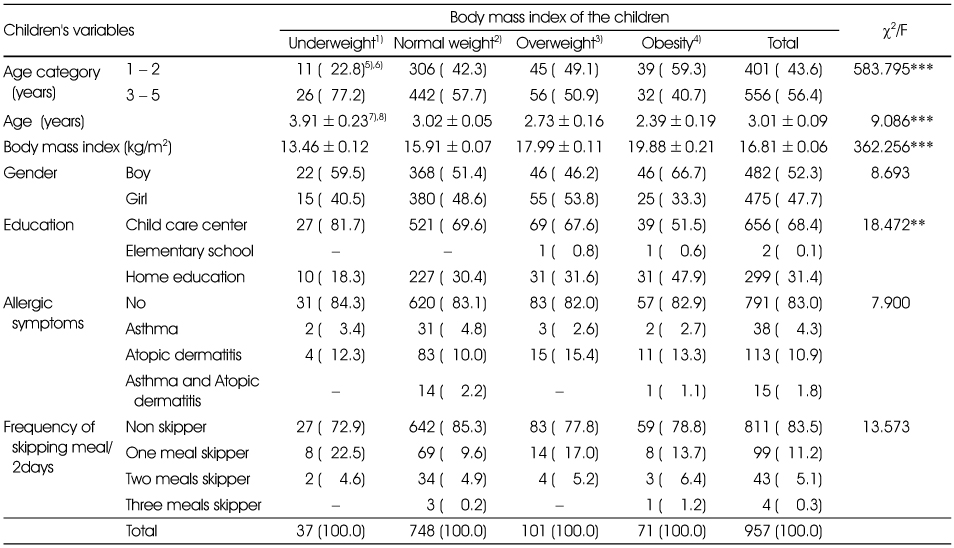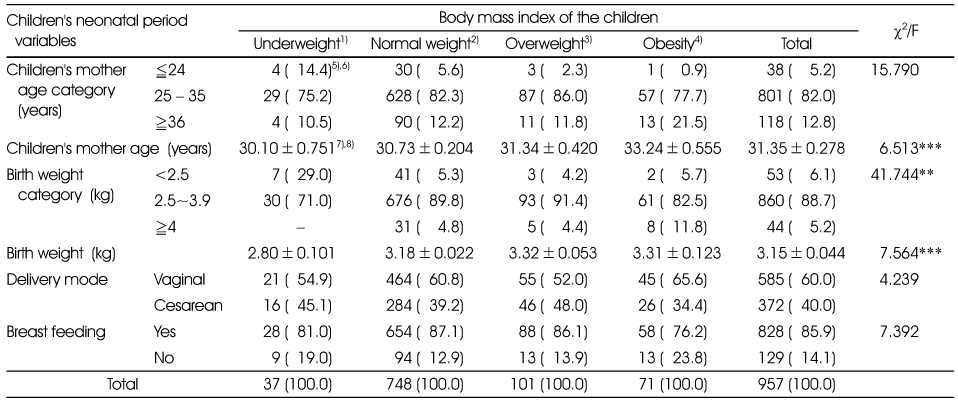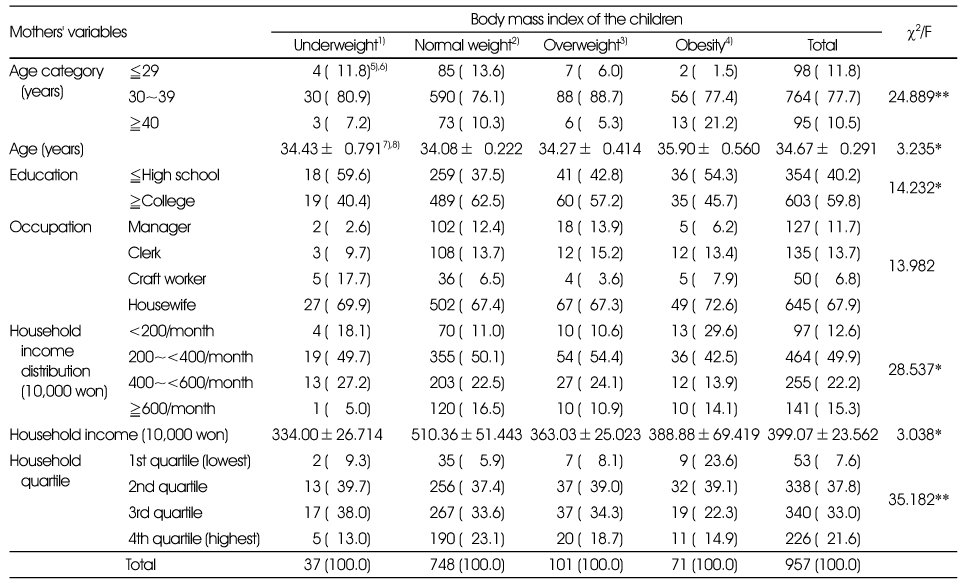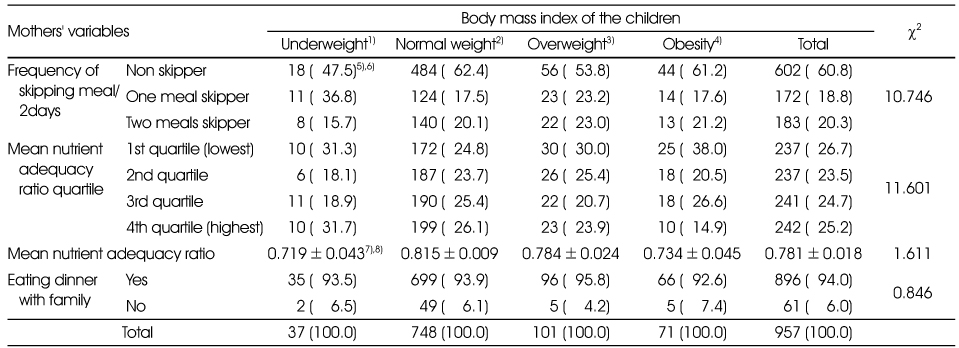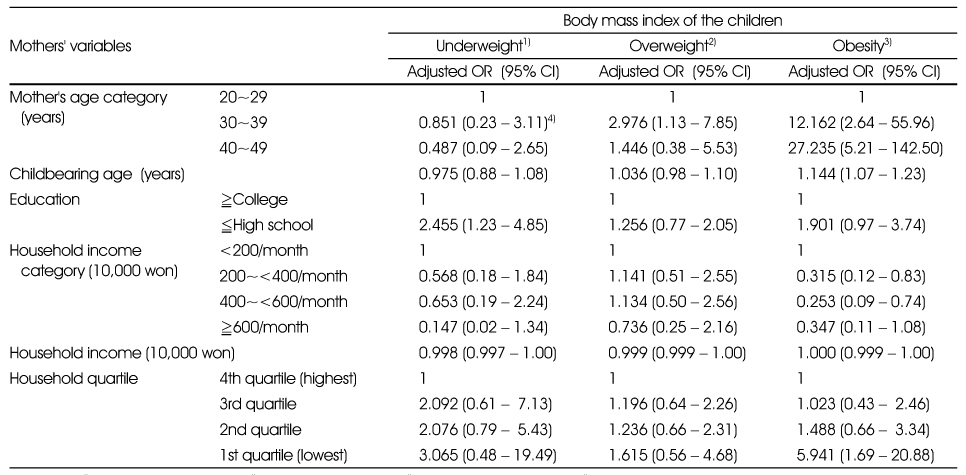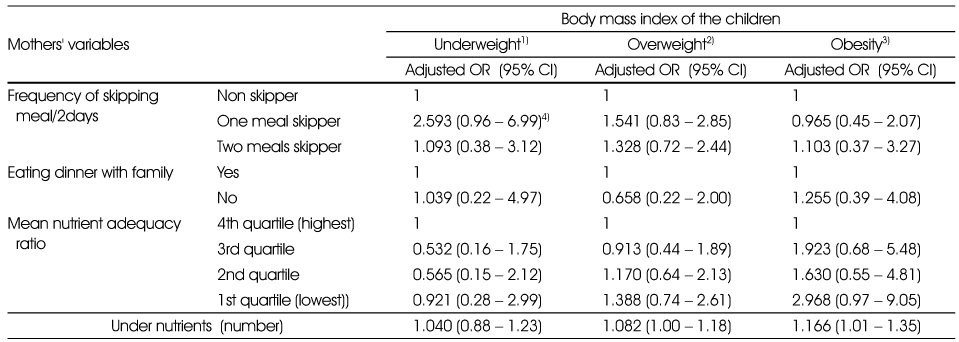References
1. Matheson D, Spranger K, Saxe A. Preschool children's perceptions of food and their food experiences. J Nutr Educ Behav 2002;34(2):85–92.
2. Ministry of Health and Welfare. Korea Health Statistics 2013: Korea National Health and Nutrition Examination Survey [KNHANES VI-1] [internet] 2014. cited 2015 Nov 10. Available from:
https://knhanes.cdc.go.kr/knhanes/index.do.
3. Gallagher D, Visser M, Sepulveda D, Pierson R, Harris T, Heymsfield SB. How useful is body mass index for comparison of body fatness across age, sex, and ethnic groups? Am J Epidemiol 1996;143(3):228–239.
4. Moon JS, Lee SY, Nam CM, Choi JM, Choe BK, Seo JW. 2007 Korean National Growth Charts: review of developmental process and an outlook. Korean J Pediatr 2008;51(1):1–25.
5. Garn SM, Clark DC. Trends in fatness and the origins of obesity Ad Hoc Committee to Review the Ten-State Nutrition Survey. Pediatrics 1976;57(4):443–456.
6. Koziel S, Kolodziej H. Birth order and BMI in teenage girls. Coll Antropol 2001;25(2):555–560.
7. Aull JL, Rowe DA, Hickner RC, Malinauskas BM, Mahar MT. Energy expenditure of obese, overweight, and normal weight females during lifestyle physical activities. Int J Pediatr Obes 2008;3(3):177–185.
8. Bandini LG, Schoeller DA, Cyr HN, Dietz WH. Validity of reported energy intake in obese and nonobese adolescents. Am J Clin Nutr 1990;52(3):421–425.
9. Sekine M, Yamagami T, Handa K, Saito T, Nanri S, Kawaminami K. A dose-response relationship between short sleeping hours and childhood obesity: results of the Toyama Birth Cohort Study. Child Care Health Dev 2002;28(2):163–170.
10. von Kries R, Toschke AM, Wurmser H, Sauerwald T, Koletzko B. Reduced risk for overweight and obesity in 5-and 6-y-old children by duration of sleep-across-sectional study. Int J Obes Relat Metab Disord 2002;26(5):710–716.
11. Gallaher MM, Hauck FR, Yang OM, Serdula MK. Obesity among Mescalero preschool children. Association with maternal obesity and birth weight. Am J Dis Child 1991;145(11):1262–1265.
12. Oken E, Taveras EM, Kleinman KP, Rich-Edwards JW, Gillman MW. Gestational weight gain and child adiposity at age 3 years. Am J Obstet Gynecol 2007;196(4):322.
13. Gillman MW, Rifas-Shiman SL, Camargo CA Jr, Berkey CS, Frazier AL, Rockett HR. Risk of overweight among adolescents who were breastfed as infants. JAMA 2001;285(19):2461–2467.
14. Toschke AM, Vignerova J, Lhotska L, Osancova K, Koletzko B, von Kries R. Overweight and obesity in 6- to 14-year-old Czech children in 1991: protective effect of breastfeeding. J Pediatr 2002;141(6):764–769.
15. Li L, Parsons TJ, Power C. Breast feeding and obesity in childhood: cross sectional study. BMJ 2003;327(7420):904–905.
16. Cutting TM, Fisher JO, Grimm-Thomas K, Birch LL. Like mother, like daughter: familial patterns of overweight are mediated by mothers' dietary disinhibition. Am J Clin Nutr 1999;69(4):608–613.
17. Brich LL. The role of experience in children's food acceptance patterns. J Am Diet Assoc 1987;879 Suppl. :S36–S40.
18. Wright DE, Radcliffe JD. Parents' perceptions of influences on food behavior development of children attending day care facilities. J Nutr Educ 1992;24(4):198–201.
19. Auld G, Boushey CJ, Bock MA, Bruhn C, Gabel K, Gustafson D. Perspectives on intake of calcium rich foods among Asian, Hispanic and white preadolescent and adolescent females. J Nutr Educ Behav 2002;34(5):242–251.
20. Korea Center for Disease Control and Prevention, The Korean Pediatric Society, The Committee for the Development of Growth Standard for Korean Children and Adolescents. 2007 Korean Children and Adolescents Growth Standard [internet] 2007. cited 2015 Nov 10. Available from:
http://www.cdc.go.kr/cdc/.
21. Kim SM, Ko JH, Shim EJ, Lee DH, Cho DJ, Kim DH. Serum creatinine, blood urea nitrogen change in low birth weight infants during their first days of life. Korean J Perinatol 2008;19(2):181–189.
22. Wen CP, Cheng TYD, Tsai SP, Chan HT, Hsu HL, Hsu CC. Are Asians at greater mortality risks for being overweight than Caucasians? Redefining obesity for Asians. Public Health Nutr 2009;12(4):497–506.
23. Klesges RC, Klesges LM, Eck LH, Shelton ML. A longitudinal analysis of accelerated weight gain in preschool children. Pediatrics 1995;95(1):126–130.
24. Charney E, Goodman HC, McBride M, Lyon B, Pratt R. Childhood antecedents of adult obesity: Do chubby infants become obese adults? N Engl J Med 1976;295(1):6–9.
25. Hashimoto N, Kawasaki T, Kikuchi T, Takahashi H, Uchiyama M. Influence of parental obesity on the physical constitution of preschool children in Japan. Acta Paediatr Jpn 1995;37(2):150–153.
26. Kivimäki M, Lawlor DA, Smith GD, Elovainio M, Jokela M, Keltikangas-Järvinen L. Substantial intergenerational increases in body mass index are not explained by the fetal overnutrition hypothesis: the cardiovascular risk in Young Finns study. Am J Clin Nutr 2007;86(5):1509–1514.
27. Park JK, Ahn HS, Lee DH. Nutrient intake and eating behavior in mid and severely obese children. J Korean Soc Study Obes 1995;4(1):41–50.
28. Skinner JD, Carruth BR, Bounds W, Ziegler P, Reidy K. Do food-related experiences in the first 2 years of life predict dietary variety in school-aged children? J Nutr Educ Behav 2002;34(6):310–315.
29. Moon JY, Hahn WH, Shim KS, Chang JY, Bae CW. Changes of maternal age distribution in live births and incidence of low birth weight infants in advanced maternal age group in Korea. Korean J Perinatol 2011;22(1):30–36.
30. Lee JJ. Effect of women's first childbearing age on the risk of low birth weight. Korean J Pediatr 2007;50(12):1206–1211.
31. Kristensen S, Salihu HM, Keith LG, Kirby RS, Pass MA, Fowler KB. Impact of advanced maternal age on neonatal survival of twin small-for-gestational-age subtypes. J Obstet Gynaecol Res 2007;33(3):259–265.
32. Moon HK, Song BH, Chung HR. Environmental factors affection growht of preschool children in Korea: Analysis with weight-length index. J Korean Public Health Assoc 1992;18(1):193–205.
33. He Q, Ding ZY, Fong DYT, Karlberg J. Risk factors of obesity in preschool children in China: a population -based case- control study. Int J Obes Relat Metab Disord 2000;24(11):1528–1536.

